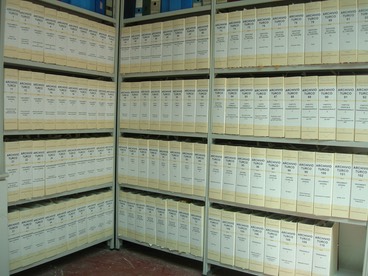THE ILLICIT DRUG PROBLEM
IN SOUTH WEST ASIA
Situation Analysis
Supply of Narcotic Drugs
The so-called "Golden Crescent" -- encompassing the poppy producing areas of Southwest Asia -- is one of the world's main sources of illicit opiates. Afghanistan and Pakistan are both opium-producing countries. Following the 1979 revolution, Iran's opium poppy crop was largely eradicated though some minor residual amounts may be grown on a non-commercial scale.
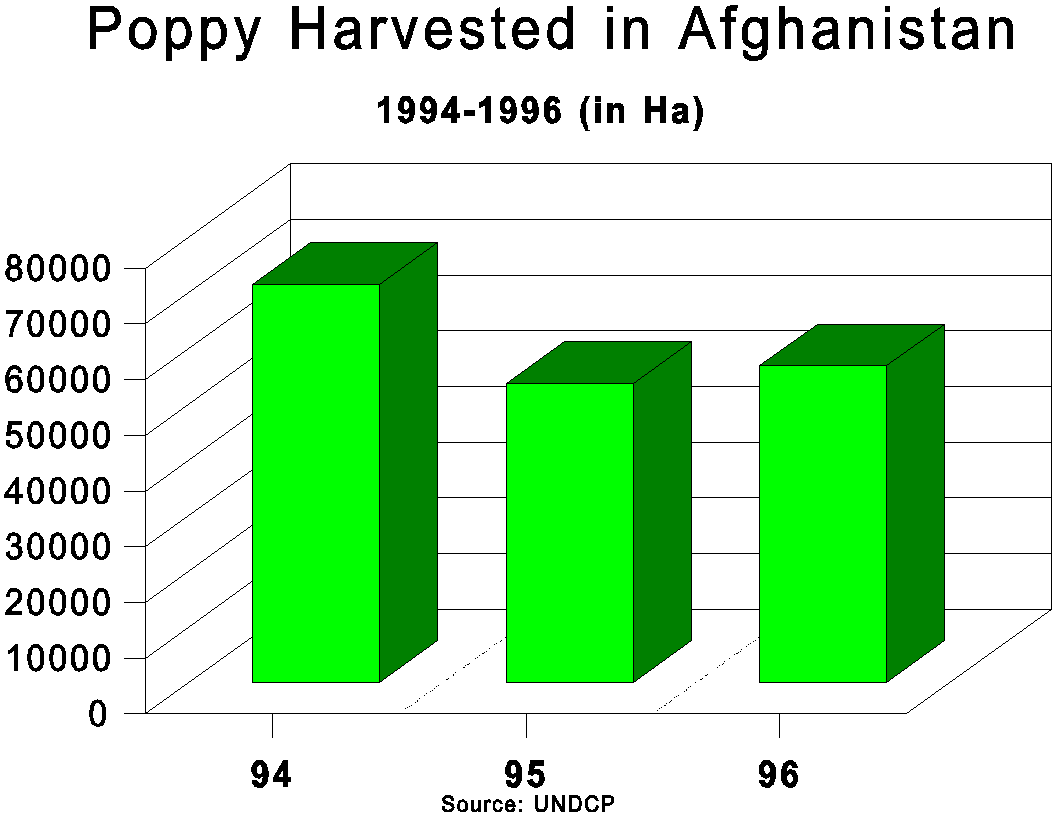
Figure 1: Following a bumper harvest in the 1993/94 season, the area harvested has declined the past two years principally due to over-supply in earlier years, although an attempt at eradication in Nangarhar province and adverse weather conditions are thought to have contributed.
The continuing civil strife in Afghanistan has created conditions that, in the 1990s, have boosted Afghanistan into a position as the world's largest producer of illicit opiates (see Figure 1). In terms of sheer production volume, it is rivalled only by Myanmar in SE Asia. It harvests 50 times more opium than Pakistan. According to the results of the 1996 poppy survey the decline in area harvested between 1994 and 1995 -- a fall from 71,000 Ha to 54,000 Ha -- has been sustained into 1996. The area harvested in 1996 is estimated to range between 55-58,000 Ha (the computer figure is 56,848 Ha -- see Figure 1). The province of Helmand has been again confirmed as the major poppy cultivator, surpassing its former competitor as top producer, Nangarhar.
Pakistan has been a producer of opium for export since the time of Muslim rule and the later British empire. Beginning in 1979, large-scale heroin production has also taken place in the country. An analysis of the 1996 growing season in Pakistan suggests a substantial decline in the amount harvested from 4,709 hectares (Ha) in 1995 to 1,038 Ha this year. This continues the downward trend witnessed over the past 4 years which is depicted in Figure 2.
Cannabis is also produced in large quantities in the three countries of this sub-region, but complete information is not available. Most of the cannabis trafficked in the region originates in Afghanistan. It tends to be processed in the inaccesable areas of Pakistan's Orakzai and Kurram agencies and the Tirah area of Khyber agency. It then travels by caravan through the tribal areas bordering NWFP in the direction of Baluchistan for transportation out of the country via Iran or the Mekran coast. If processed in Afghanistan the most likely outbound route is via the Central Asian Republics in trucks or containers.
Processing and Trafficking
Processing and trafficking problems affect the region and the wider world beyond. Indicative routes are illustrated in Figure3.
Most processing takes place in small, mobile laboratories in the Afghan-Pakistan border areas although increasing instances of processing on the Afghan border with the Central Asian Republics have been reported. The subregion itself has become a major consumer market for opiates produced. Opiate processing on both sides of the Pakistan-Afghan border has created a trafficking and, importantly in the case of Pakistan, a drug abuse problem especially since the early 1980s. Europe, and to a lesser degree the United States of America, are destinations for the higher grade of heroin opiates exported from this region. In the recent past, there has been some success in suppressing heroin laboratories in the tribal areas of Pakistan (especially Khyber and Mohmand agencies). The seizure figures for opiates (excluding morphine base) in the subregion are given in Table A. A 1993 survey of the illicit opiate industry has suggested that Pakistan could be a net importer of illicit opiates to feed its burgeoning rate of demand. The new drug production and processing areas which are reportedly emerging in the Central Asian Republics when combined with the displacement of trafficking northward from Afghanistan, to Russia and to the European market represent matters of serious concern.
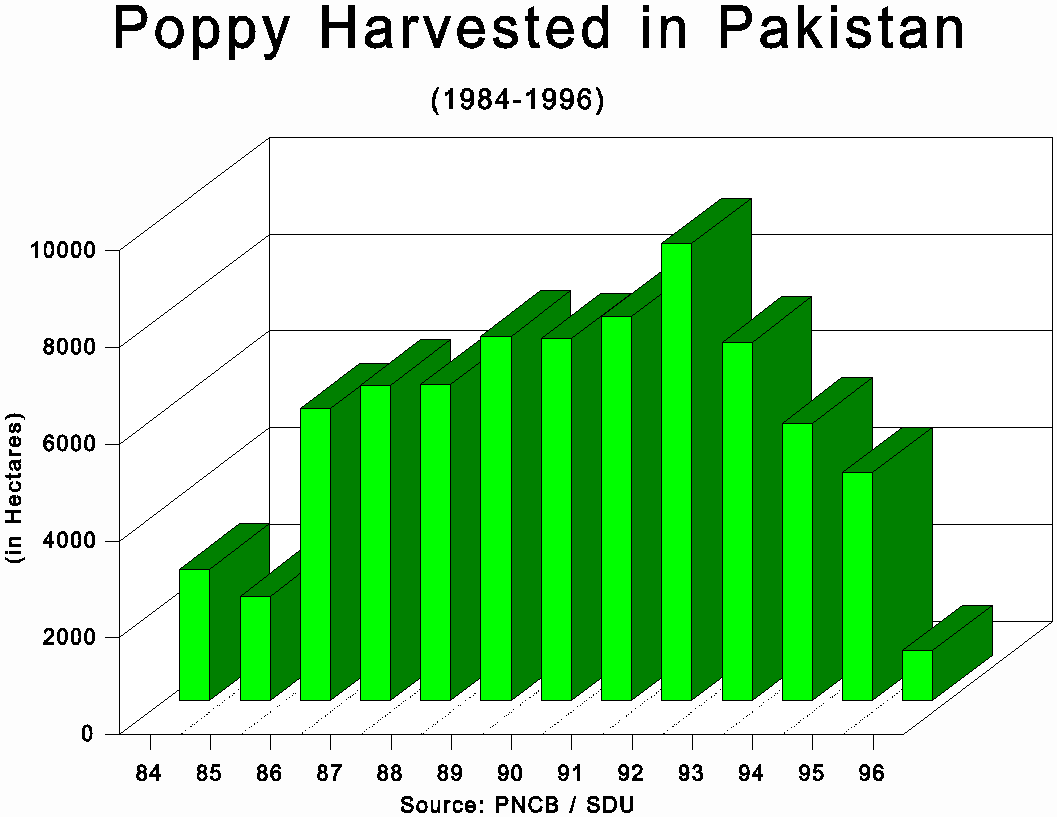
Figure 2: Following the enforcement of Hadd Ordinance in 1979, poppy cultivation and resultant opium production declined steeply in Pakistan until the mid 1980s when the possibility of tremendous profits pushed up the cultivation. Since the recent cultivation peak in 1992/93, however, cultivation has consistantly declined with the fall in 1996 being the steepest.
Abuse of Narcotics
While estimates on the extent of drug addiction in Afghanistan are not available, reports indicate a serious problem (a) among the Afghan refugee population in Pakistan, (b) in the Afghan province of Badakshan (c) among returning refugees in Kabul and (d) among the Turkmen tribes of North Afghanistan. Hashish, opium and heroin seem to be the preferred drugs among the male population. Figures given by the Iranian authorities indicate an addict population of 350,000 and 150,000 for opium and heroin respectively. Pakistan is one of the countries hardest hit by narcotics abuse in the world. According to national drug abuse surveys, the number of chronic abusers of heroin increased from about 20,000 in 1980 to more than 1.5 million in 1994. Moreover, the results of a national survey suggest a total number of chronic drug abusers just topping 3 million in 1993.
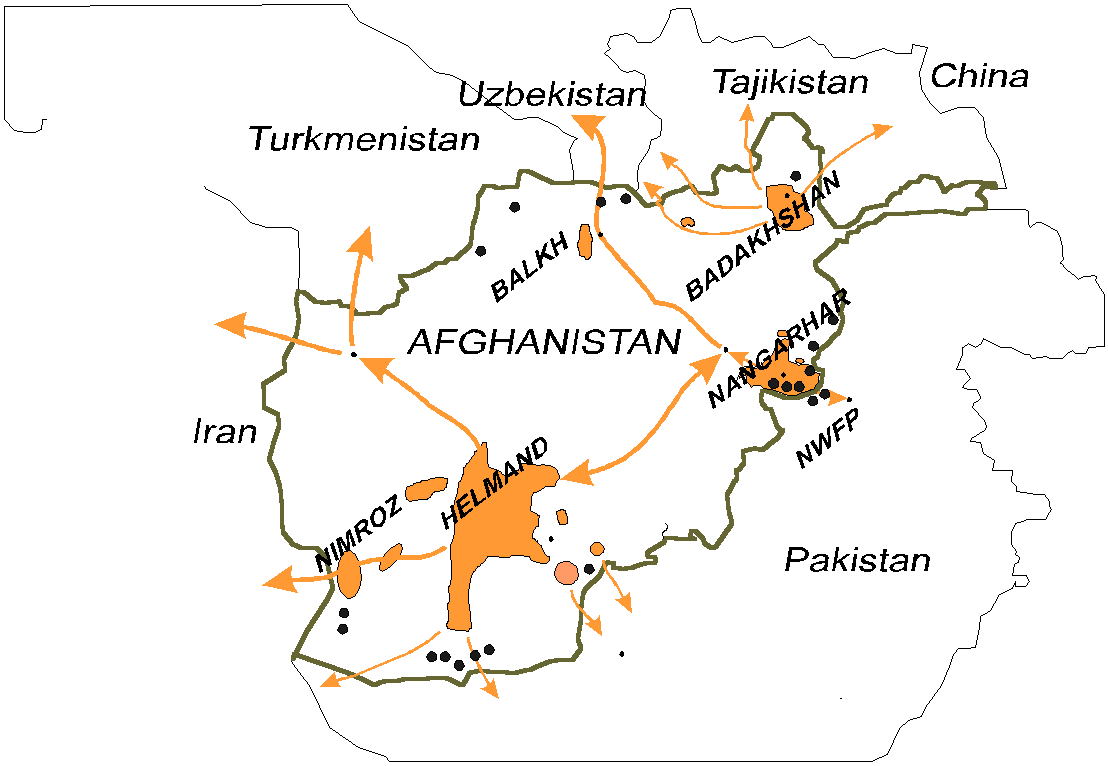
Figure 3: The illustation above depicts the main cultivation zone in Afghanistan as well as the main routes used to transport opiates out of the country. Estimates of the volume of the traffic leaving the country via the surrounding states are of a necissity imprecise, and so the routes are indicative. Latest reports have been used to pinpoint the areas where heroin laboratories are known to be operating. These are depicted with black dots which are also indicitive in nature. It should also be noted that the number of labs does not corelate to volume of production in a linear fashion. For example, in the Peshawar/Nangarhar area there are approximately five times as many labs as anywhere else in the subregion, but these labs tend to be smaller than those in the southwest Afghanistan. Thus from the point of view of production volume the following percentages apply: Peshawar/Nangarhar (50%) -- most of the heroin #3 produced in the area is destined for pakistani consumption with pure heroin being onforwarded to the west; Helmand (25%) -- almost all morphine base and bound for Iran: Nimroz (10%) -- situation same as Helmand; Badakhshan (10%) -- crude morphine base ("black tar"); Afghan border with Uzbekistan/Turkmenistan (5%).
Drugs are mostly ingested orally, heroin is usually smoked or the smoke is inhaled. In Pakistan, a small number of heroin injection cases have begun to emerge in the Karachi area. This practice -- previously unknown in the subregion -- has been observed in recent studies and raises concerns about the increased risk of transmitting blood-borne diseases, such as hepatitis and HIV/AIDS, through the process of needle sharing.
UNDCP Response
In July 1993, in response to an identified need for sub-regional cooperation in drug abuse control, UNDCP upgraded its office in Pakistan to the level of a Regional Office. The office is responsible for assisting the Governments of the region in planning, implementing and coordinating drug control policies and strategies. Particular emphasis is placed on encouraging and promoting cooperation between and among these countries on drug control matters.
The activities of UNDCP in the countries of the South West Asia Region were focused throughout 1980s on supply reduction through integrated rural development or alternative development projects. The changing nature of the drug problem and lessons learned have however led to reorientation of the programme. More emphasis is being given to the activities related to demand reduction, combat against illicit drug trafficking and to support collaboration between countries of the region. While increased attention will be given to demand reduction, law enforcement and regional drug control collaboration, support to the supply reduction activities, particularly in Afghanistan will be continued.
In the biennium 1996-97, UNDCP programme and project activities will focus on the following areas:
a. Supply Reduction
The objective is to support the implementation of alternative development activities which provide alternative sources of income to the poppy farmers in order to induce them to cease cultivation of an illicit substance. The aim in providing such assistance is to arm resource-poor governments with justification to threaten the use of sterner measures to control cultivation and production. UNDCP believes that an effective strategy to eliminate cultivation of narcotic crops will require alternative development combined with law enforcement. In Afghanistan, UNDCP has conducted three successive measurement of crop production and yields of the opium poppy in the period 1994-96. The Government of Pakistan's strategy in this regard has been to continuously monitor the evolution of drug supply and demand through regular surveys.
Over the past five years, UNDCP has been working in opium-producing provinces ofAfghanistan through the Drug Control and Rural Rehabilitation project implemented out of Peshawar. The nature and scope of UNDCP's supply-reduction interventions in Afghanistan are taking shape following an extended review of the best strategy to adopt in this particularly difficult setting. A 4-year US$17m programme is anticipated to be in place during the first quarter of 1997. The programme will continue the annual poppy crop surveys which UNDCP has undertaken since the 1993/94 season. Over the past few years, the Government ofPakistan, with the assistance of the international community, has been able to isolate and restrict poppy cultivation to three areas in the NWFP: Dir district, Bajaur agency and Mohmand agency. Having started alternative development assistance to Dir in 1985 -- at which time the focus was heavily infrastructure-oriented -- UNDCP continues to provide area and community development assistance in the district. Ongoing liaison and cooperation occurs with the United States, the other main donor providing assistance to Bajaur and Mohmand. UNDCP is also supporting the Special Development Unit of the NWFP Planning Department which is responsible for overall coordination and monitoring of poppy-eradication projects in Pakistan.
b. Law Enforcement
The experience of UNDCP in South West Asia demonstrates that development assistance is a necessary -- but by itself insufficient -- instrument for the successful reorientation of poppy-growing farmers away from illicit cultivation. Self-enforcement has not been seen to work. Law enforcement is therefore essential in the domain of production and trafficking of illicit narcotic substances. UNDCP's aim in Afghanistan, as in other major producing countries, is therfore to support legitimate efforts to enforce the laws against the cultivation, production and trafficking of illicit narcotic and psychotropic substances. However, following 17 years of war and the resultant virtual collapse of the civil state and of national institutions, enforcement initiatives in the Afghan context are particularly difficult.
In view of the precarious situation in Afghanistan, UNDCP has sought to concentrate, rather, on supporting law enforcement cooperation initiatives in the states bordering the region's major producer. Considerable attention has been placed, to date, on strengthening drug law enforcement interdiction capacities on the joint Pakistan / Iran< border and supporting similar efforts of those Central Asian Republics lying just to the north of Afghanistan. In the context of Pakistan and Iran, the strategy is to enhance the physical controls and level of existing expertise as well as to strengthen weak points. UNDCP launched a subregional project in October 1994 which has improved cross-border telecommunication facilities, the mobility of border forces and enhanced cross-border cooperation in drug control operations. Under the training segment of the project, cascade training in drug law enforcement is continuing on both sides of the border. The possibility of extending the current Pakistan / Iran project along these countries' respective borders with Afghanistan is being pursued in the current biennium.
c. Demand Reduction
Pakistan has been the major sufferer in what has, since the early 1980s, been a largely supply-driven explosion in abuse of opiates. As a consequence, demand reduction has become top priority for the Government of Pakistan in its fight against illicit drugs -- a fact reflected in its newly formulated Masterplan. This represents a considerable shift from the earlier heavy reliance on supply reduction and interdiction imperatives. UNDCP's strategy is therefore to ensure the consolidation of the achievements of the first phase of the Integrated Drug Demand Reduction Project (1991-96) which has been providing high-level technical inputs into the Government's efforts in awareness-creation, preventive education, treatment and rehabilitation and workplace reduction efforts. In Afghanistan, drug demand reduction activities were carried out in the previous five years within the framework of UNDCP's Drug Control and Rural Rehabilitation project. Emphasis was placed on awareness creation. The new programme, with a budget of approximately $1.2 million, will continue this emphasis, and in addition make a significant contribution in the areas of treatment, rehabilitation and aftercare of drug dependent persons.
d. Sub-regional Cooperation
UNDCP believes that intensified collaboration between the countries of the subregion has a great potential to make monitoring of cross border movements more effective and to provide a basis for improved control of illicit drug trafficking. A principal objective of UNDCP is therefore to complement its current country programmes for Pakistan and Afghanistan with the establishment of effective subregional cooperation in drug control matters. UNDCP has therefore worked with the countries in the region to formalize subregional initiatives between Pakistan and both Iran and India. In 1994 Pakistan signed a Memorandum of Understanding with Iran and UNDCP to control drug trafficking across the border. In the same year, an agreement was signed with India to control the cross border smuggling of precursors and narcotics. The development of regional plans for drug control under the auspices of ECO and SAARC should significantly enhance the extent of sub regional cooperation. UNDCP has signed memoranda of understanding with both organisations, and discussions regarding the establishment of a regional drug control mechanism continue.
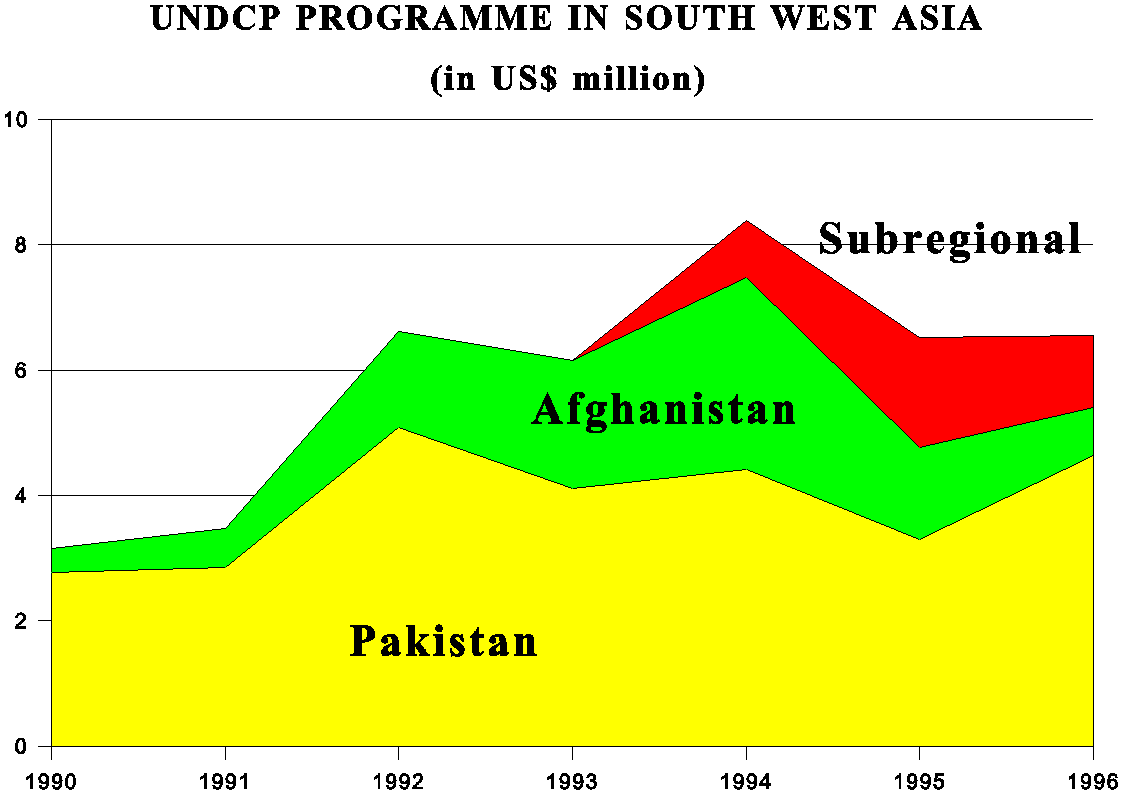
Figure 4: Financing the UNDCP programme in SW Asia - The illustration reflects actual expenditures by UNDCP in the region for the past six years. In 1996, the figure given is for funds alloted. The development of a new 4-year, $17 million programme for Afghanistan, due to begin implementation in the first quarter of 1997 should substantially increase expenditure in that country between 1996 and 2000


